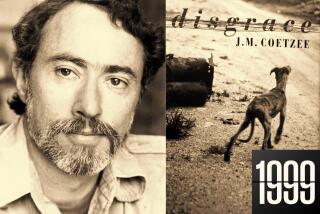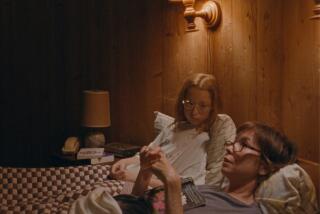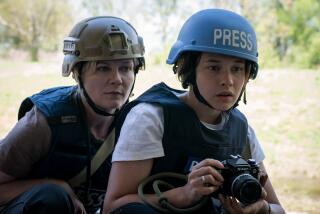Love is a battlefield
- Share via
From her 1983 debut, “Union Street,” a gritty portrait of working-class women, through her searing depiction of war in the Booker Prize-winning “The Ghost Road,” the last installment in her “Regeneration” trilogy, to her searching examination of a reporter’s moral responsibility for what he witnesses in “Double Vision,” English novelist Pat Barker has always asked hard questions. What does violence do to its victims and perpetrators? How do the wounds of the past infect the present? What responsibility do we accept for the suffering of others? A natural storyteller as well as a passionate novelist of ideas, Barker embeds these questions in the particular experiences of her complex, conflicted characters. Each book is different, and each time you think you’ve got her work figured out, she surprises you.
She ably evades our expectations once again with “Life Class.” Paul Tarrant and Elinor Brooke are students at London’s Slade School of Fine Art in early 1914. Paul is paying his tuition with a small legacy from his grandmother, who clawed her family’s way out of poverty; he’s still grappling with her admonition: “Art! It’s not for people like us.” Elinor contends with a well-to-do mother who thinks painting is a “nice little hobby” and with male colleagues who say things like, “Your eyes aren’t for looking. They’re for being looked at.”
That comment comes from Elinor’s would-be-lover Kit Neville, who left Slade two years before and is already making a splash as a painter. When World War I begins, Kit volunteers as an ambulance driver because “it’s the fastest way out there” and he wants to get the gruesome images onto his self-consciously virile canvases right away. “You really do see it as a painting opportunity, don’t you?” says Paul. “Too bloody right I do,” Kit replies.
World War I, England’s stultifying class system, strong women chafing against cultural constraints, the thorny ethical issues raised when art takes atrocity as its raw material -- these are familiar topics in Barker’s fiction. But they’re all fresh here, seen from new perspectives that illuminate the personalities and relationships of people she hasn’t written about before. Paul is floundering as the novel begins. The technical proficiency that got him into Slade doesn’t impress Henry Tonks (a real-life figure), feared professor of the school’s life drawing class. “You seem to have nothing to say,” Tonks tells Paul. “Why don’t you start by asking yourself: Do I want to paint? Or do I want ‘to be an artist’?”
“Well, of course he wanted to be an artist. It was the opposite of the life he’d lived in the shadow of the ironworks that gobbled men up at the start of a shift and regurgitated them twelve hours later fit for nothing but booze and sleep,” Barker writes of Paul. It infuriates him that spoiled, self-pitying Kit has produced masterful paintings of the industrial environment Paul left behind. Kit is a tourist in the landscape of misery, but he knows what he wants, and Paul doesn’t. They vie for Elinor, who vows that “no man was ever going to entice her into a cage. . . . She was an artist, for God’s sake.” She’s drawn to Kit because, like him, she’s determined to let nothing stand in the way of fulfilling her talent. But like Paul, she’s unsatisfied with her work, “reek[ing] of Sladery and winning prizes and wanting to be praised.” The war will bring disquieting artistic fulfillment to Elinor and Paul, the blaze of success he’s always wanted to Kit.
But that’s in Part 2. The first half of “Life Class” is almost disconcertingly low-key. Paul has an affair with an artist’s model whose estranged husband beats him up, hints are dropped that Elinor’s friendships with other women are a little intense, visits to Elinor’s and Kit’s families establish the gulf between their privileged backgrounds and Paul’s, everyone drinks and gossips at the local cafes. Though readable and intelligent, these chapters seem rather aimless. Like the characters, readers are waiting to see what war will bring.
“Everything stinks: creosote, bleach, disinfectant, soil, blood, gangrene.” With these blunt words, which open Part 2, the scene shifts to a front-line hospital where Paul is an orderly, and the slightly abstract preoccupations of young people trying to figure out the direction of their lives are subsumed in the brutal, smelly reality of death. Barker has written before about the hideous physical damage inflicted by war. Here she opens a new area of inquiry: the toll it takes on those who tend to the damaged. “Leave your . . . compassion at the door, it’s no use to anybody here,” Paul wants to say to a recently arrived volunteer. The young man’s shock revives emotions Paul has repressed in order to do his work. The question of how much he can allow himself to feel for the horribly wounded soldiers dogs him throughout his service.
At the same time, with piercing irony, the war gives Paul something to say in his art. He begins sketching patients, rents a room in town where he can paint and produces a canvas depicting his grim hospital duties that is the best thing he’s ever done. He doesn’t care that no gallery would exhibit such images, he tells Elinor; “it’s not right their suffering should just be swept out of sight.” Their thoughtful correspondence during the war’s early months has drawn Paul and Elinor closer, and she’s forged papers to visit him at the front, but she’s appalled by what he’s doing. “You can’t use people like that,” she says.
They smooth over their differences and make love for the first time the evening of her arrival. Nonetheless, the letters they exchange following her return to London show two decent, honorable people being driven apart by their very different responses to the war. “What are we fighting for?” asks Elinor, outraged by the internment of a friend’s German-born father and the jingoism she sees around her. She refuses to read the newspapers and works furiously. “If painting matters you have to give your life to it and that’s what I’m doing,” she writes Paul. “I find it hard to cross the desert that divides us. . . . This war destroys so much, don’t let it destroy us as well.”
Yet Paul can’t leave the war behind, even when he’s sent home after being wounded. He won’t agree with Elinor that it’s fundamentally meaningless, “a train crash” that should be ignored as much as possible; that would mean betraying his dead friends and the images he feels compelled to record. He senses an odd kinship with Kit, “the great war artist . . . beaming, rubicund, gleaming with success,” who at least understands “the Faustian pact” they’ve both made by putting other people’s sufferings on canvas. “The sooner he was out there again the better,” Barker has Paul thinking, as he slips out of Elinor’s bed. “He didn’t belong here.”
Barker’s tragic vision acknowledges that love can’t erase all divisions, that not all wounds can be healed, that people battered by the forces of history can’t command their fate. Yet her novels are so warmly human in tone, so artistically satisfying in execution, that they inspire exhilaration even in their saddest moments. “Life Class” leaves us with a profound sense of gratitude for writers like Barker who are able to look at the world’s frequent sorrows and occasional splendors with unflinching compassion.
More to Read
Sign up for our Book Club newsletter
Get the latest news, events and more from the Los Angeles Times Book Club, and help us get L.A. reading and talking.
You may occasionally receive promotional content from the Los Angeles Times.







